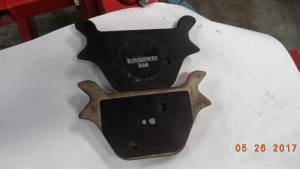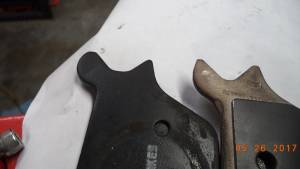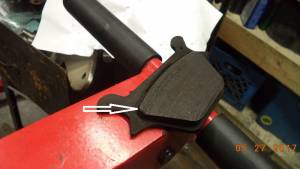Table of Contents
This is an old revision of the document!
REF: Wheels, Brakes & Tires
Brake Pads - Aftermarket, Break-in etc
Brake Pad Break-in (burnishing)
The forgoing applies to factory brake pads and discs only.
When using aftermarket pads / discs, refer to the manufacturer for the proper break-in procedure.
Burnishing is the process that occurs as the pads and disc wear into one another. 1)
Burnishing is complete when the pad and disc contact surfaces are fully worn into each other, thus providing maximum contact.
Early disc brake systems with organic type pad materials needed fairly harsh break-in braking to burnish the disc and pads.
The 86-90 FSM says to burnish by applying several hard stops after new pads have been installed. 2)
This, of course, is assuming you are using the factory 86-90 organic brake pads.
Note: Using 1991 and earlier brake pads with 1992 stainless steel rotors will cause premature rotor wear. 3)
For maximum service life, a new brake rotor should only be installed with the recommended replacement brake pads.
If you install a new rotor, also install the recommended brake pads for that particular rotor.
1992 Brake Pads and Stainless Steel Brake Discs.
With the change in brake disc and pad material for 1992, comes a change in the break in burnishing procedure.
The new combination of a softer disc and more aggressive sintered metal pads allows the normal burnishing process to scratch the disc more than before.
This grooving is normal and will diminish after burnishing is achieved.
With the new combination, burnishing can no longer be achieved by making repeated hard stops.
In fact, this practice can cause premature wear.
Repeated hard stops can generate excessive heat causing material transfer between pads and disc.
Burnishing pads and discs can only be done properly by normal brake operation through the vehicle's break-in
period.
Brake System
See also Bleeding the Brake Lines In the REF section of the Sportsterpedia.
- Brake caliper mounting bolt O-rings- Dow Corning 44 grease (“Pin Lube” in parts kit) 4)
- O.D. of brake caliper piston (including chamfer), caliper piston bore and I.D. of the installed piston seal - Novaguard silicon grease.
- I.D. of upper caliper (threaded) bushing bore, O.D. of threaded bushing, I.D. of upper and lower caliper mounting pin bores - Dow Corning 44 grease (“Pin Lube” in parts kit) 5)
Aftermarket Brake Parts
Aftermarket brakes vs OEM brakes Check fitment of aftermarket brakes before using them. Just because they are published as 'will fit your vehicle' doesn't make it so. The pics below are a comparison of OEM brakes and an aftermarket brand:
The light colored OEM brake has sharper contours to match up to the screw mounting bracket shims it rides against. The aftermarket brand is slightly shorter in length than OEM which allows it to wiggle around a bit since it doesn't fit tight against the screw shims which can allow it to drop below the disc resulting in poor pad wear and possible disc wear or disc drag as in the pic below:
Be sure your brakes can not wiggle around before installing the caliper.



